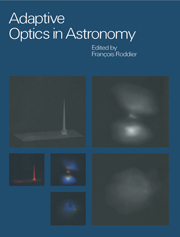Book contents
- Frontmatter
- Contents
- List of contributors
- Part one Introductory background
- Part two The design of an adaptive optics system
- Part three Adaptive optics with natural guide stars
- Part four Adaptive optics with laser beacons
- Part five The impact of adaptive optics in astronomy
- 14 Observing with adaptive optics
- 15 Astronomical results
- 16 Future expectations
- Glossary of acronyms
- Index
14 - Observing with adaptive optics
from Part five - The impact of adaptive optics in astronomy
Published online by Cambridge University Press: 23 November 2009
- Frontmatter
- Contents
- List of contributors
- Part one Introductory background
- Part two The design of an adaptive optics system
- Part three Adaptive optics with natural guide stars
- Part four Adaptive optics with laser beacons
- Part five The impact of adaptive optics in astronomy
- 14 Observing with adaptive optics
- 15 Astronomical results
- 16 Future expectations
- Glossary of acronyms
- Index
Summary
In this chapter, we consider how the astronomer may use an adaptive optics system, what kind of performance can be expected in a particular program, and how observations should be prepared. We also discuss what precautions must be taken during data acquisition, with special emphasis on how to keep proper track of the overall impulse response including the atmosphere. We give some advice, and discuss specific data reduction procedures.
Estimating performance
In addition to the art of imaging, well known to astronomers, the AO methodology adds the necessity of considering a constantly changing atmosphere and atmospheric seeing. Such a changeable state of affairs, departing from stationarity, is well illustrated by Fig. 14.1. Non-stationarity precludes a complete a priori knowledge of the actual performance a given system will reach at a given time: from the choice of pixel size or slit width to the selection of the operating loop frequency of the AO system or the adequacy of a given offset reference star, many observational parameters cannot be entirely pre-determined and will require real time decisions.
An a priori knowledge of the seeing at an astronomical site is therefore of importance for forecasting the atmospheric coherence time τ0 and the coherence diameter r0. At many modern observatories, programs are envisaged to deduce these values from meteorological observations, such as vertical thermal gradient and wind speed, local vorticity, etc.
- Type
- Chapter
- Information
- Adaptive Optics in Astronomy , pp. 351 - 370Publisher: Cambridge University PressPrint publication year: 1999
- 2
- Cited by



